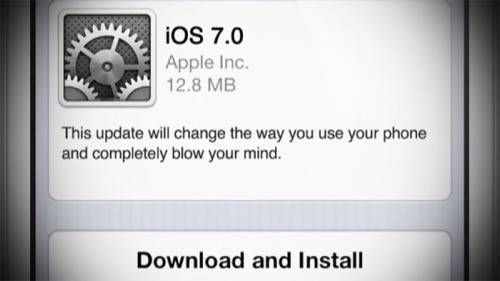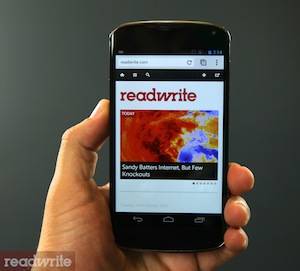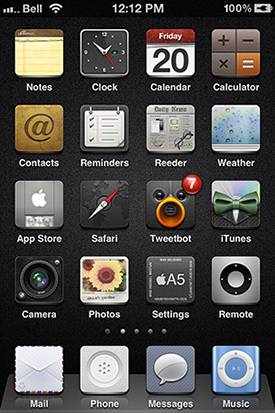
Six years in, the polish is starting to rub off. After a historic launch and years of grand slam updates to its hardware and software, the iPhone now appears more vulnerable than ever. To retains its luster, Apple needs to make iOS 7 its boldest update yet.
It pains me to admit, but Android is evolving faster than iOS these days. For years, that seemed impossible. Early Android phones felt like rusty copycats of Apple’s impeccably slick mobile platform, with far fewer apps available to their users.
With each upgrade to Android, iPhone owners laughed as the platform seemingly struggled to keep up with Apple’s bulletproof user experience. And for a while, it did struggle. But slowly, that changed. Next thing we knew, Android commanded 75% of the smartphone market. Today, instead of mocking Android, many prominent iPhone lovers are switching to Google.
Android Phones Keep Getting Better

In his (admittedly late) review of the Nexus 4, the notoriously pro-Apple MG Siegler cites the “methodical way” Google is improving Android, a detail that reminds him of Apple. “In a world without iPhone, I could definitely see myself using the Nexus 4 as my smartphone,” Siegler writes. “It is a really good device — one that Google should be proud of.”
Those are strong words from a stalwart defender of Cupertino. Siegler’s decision to stick with the iPhone is roughly representative of millions of consumers who have already established a loyalty to Apple’s mobile empire. But as Android improves, a growing number will think twice unless Apple pushes things forward more aggressively. Apple still has what many influencers consider to be the best smartphone on the market. But Google’s getting there. It’s not the mobile underdog anymore.
Siegler may not be going anywhere. But Kawasaki, Scoble and Ihnakto have already jumped ship. Who’s next?
The iPhone Needs Another iOS 5-Caliber Update
As iOS version updates go, the last one was fairly minor. The Facebook integration was nice, Siri took important steps forward and Passbook has serious potential. iOS 6 had dozens of other minor improvements, but no blockbusters. Its most anticipated feature, Maps, flopped so badly it led to a shake-up of Apple’s executive team.
Remember when iOS 5 launched? That felt like an almost revolutionary upgrade. Notification Center, iMessage, iCloud and Twitter integration were all huge. It also introduced over-the-air updates and iTunes-free device activation. Even something as imperfect as Newsstand at least represented a new play for Apple and a promising opportunity for publishers. Then, of course, the iPhone 4S introduced us to Siri.
By comparison, iOS 6 was a more subtle, iterative update. And that’s fine. But the next one needs be more like the jump to iOS 5: It’s going to need at least one experience-changing, killer feature.
I never upgraded my phone to iOS 6. I wanted to, but the desire to hang onto my jailbreak prevented me from tapping the button. Then the Maps thing happened, reinforcing my decision. By the time both of those issues were resolved, I had been using iOS 6 on my iPad for a few months and had played with a friend’s iPhone 5. Aside from maybe the ability to more competently write about Passbook, I didn’t feel any burning desire to update my phone.
In fact, the first hint of regret I felt was last week when I tried to download Google’s new Field Trip app for iOS and was informed that it required iOS 6. I realize this is purely subjective, but I couldn’t help but notice that the things luring me toward iOS 6 were Google-built apps, not Apple’s own efforts.
When you look at a device like the Nexus 4, it’s easy to why some are defecting. The hardware is nice and the operating system itself has come a long way. Even Apple diehards are able to admit that Google Now makes Siri look like a joke. Across the board, Google’s mobile design has improved dramatically, something we iOS users have been getting a taste of for the last six months. The Nexus 4 even has a cool wireless charging orb! I want one.
What Should iOS 7 Look Like?

So what can Apple to do make sure its next big launch creates that gotta-have-it foam at the mouths of consumers? The next hardware upgrade (this summer’s rumored iPhone 5S) will likely be pretty minor: slightly better cameras, a faster processor and so forth. Hopefully the model after that leaves room for substantial improvements, but in the meantime Apple has to flex its product development muscle with software.
Perfect timing. With iOS chief Scott Forstall out and superstar industrial designer Jony Ive given more authority over the visual design of Apple’s products, iOS may now be poised to take some seriously bold steps forward. To the excitement of many, Ive’s oversight is likely to mean less skeuomorphic design, but those changes probably won’t be made overnight. Let’s hope it also means a deeper retooling of the broader user experience.
Things like wireless charging, NFC and changes to the form factor may have to wait, but there are plenty of software-based enhancements that Apple users are clamoring for. Multi-user sign-in, AirDrop file-sharing, dynamic app icons that display live data, a radical expansion of Siri (by opening up an API to third parties), better app management and, of course, improvements to Apple’s Maps app are all common requests. The ability to set one’s default Web browser, maps app and email client (at the very least) would go a long way toward making iOS more user-friendly in the way that Android users already enjoy.
To get an idea of iOS’s true potential, we can just do what Apple does: Look at the jailbreak community. Many of the platform’s most celebrated features were borrowed from developers who built new concepts without Apple’s initial approval. Multitasking, copy and paste, Notification Center and data tethering are just a few examples.
Even though Apple has adopted popular jailbreak features, there remain plenty of compelling reasons to circumvent Apple’s controls. Many of them, as commenters are quick to point out, are things that Android does out of the box. They’re right. If it wants to keep Google at bay, Apple might consider letting users customize iOS more.
Wearable Computing: Apple’s Next Hardware Play?

Of course, a significant hardware update isn’t entirely out of the question. If the rumors are true, we may be getting an iOS-powered smart watch alongside the next iPhone. If executed as well as Apple is known to do things, the so-called iWatch could make up for an otherwise lackluster refresh on the iPhone 5S. A successful foray into wearable computing by this fall could give Apple a leg up over Google, whose ambitious Glass device doesn’t launch until the end of the year and is already marked by legitimate privacy concerns and potential social stigma.
An iWatch could succeed in snapping consumer excitement about Apple firmly back into place and keep the masses happy until the iPhone can get a proper hardware refresh. But even with a sleek, wearable gadget, Apple needs to push its software forward. iOS 7 needs to be indispensable.
Apple’s World Wide Developers Conference is still a few months away. What features would you like to see in iOS 7 when it’s announced? Let us know in the comments.









